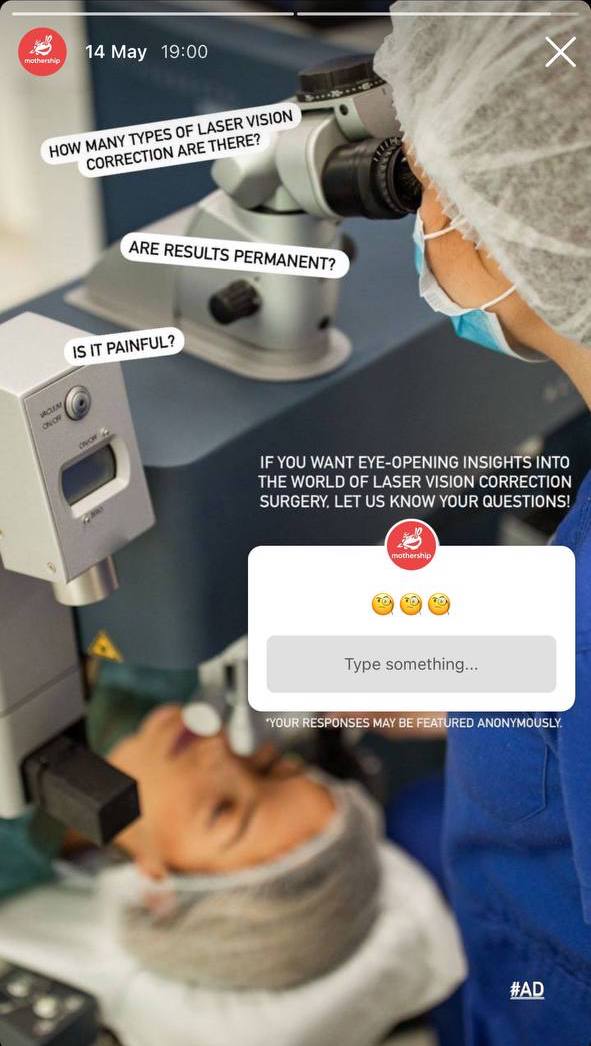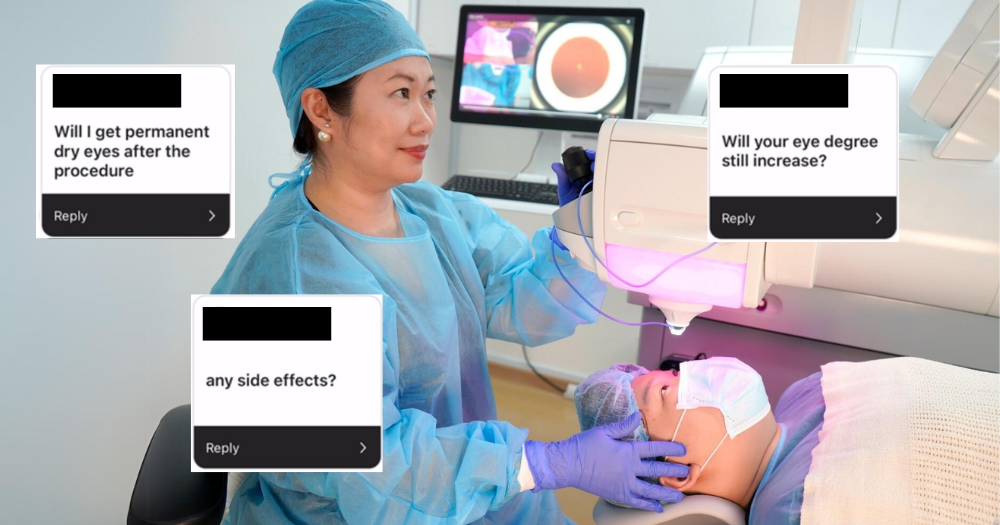Our eyes are arguably one of the most important organs in our body.
After all, they are the windows to your soul and through which you see the world.
With alternative laser vision correction procedures like ZEISS SMILE pro (more on that later), more Singaporeans are curious about improving their vision through corrective eye surgery.
Thus, we took to Instagram to ask our readers what questions they might have about laser vision correction. We then consulted the experts at LSC Eye Clinic to answer these questions.
 Screenshot via Mothership
Screenshot via Mothership
Here are five of the questions, answered by Daphne Han, an ophthalmologist with over two decades of experience:
1. Is the procedure painful?
The procedure is generally painless as it is done using numbing eyedrops, which is usually effective within the short duration of the procedure (under 10-15 minutes for both eyes).
2. Will the procedure cause dry eyes?
Dry eyes are the most common side effect following many forms of eye intervention, including corrective eye procedures like LASIK and ZEISS SMILE pro, cataract surgeries and even contact lens wear.
However, its severity may differ between the types of procedures.
For instance, it has been shown in studies that ZEISS SMILE pro reduces the risk of dry eyes as a side effect in comparison to LASIK.
This is due to it being a relatively shorter and less invasive treatment.
LASIK, on the other hand, is a flap-based procedure that incurs a larger surgical area on the cornea.
3. Are the results permanent? If not, how long do they last?
The results of laser vision correction are generally permanent.
That said, our eyes continue to age in life, together with the rest of our bodies.
Slight regression of myopia may occur due to aging, particularly if the initial degree was very high to begin with. Other factors such as prolonged screen time, eye-rubbing and hormonal changes may also contribute to fluctuation and change in eye power.
Presbyopia, the gradual loss of your eyes’ ability to focus on near objects, will eventually develop later in time, which affects everyone around the age of 40 and beyond.
Fret not though, as small adjustments by laser enhancements can be made to manage these conditions.
4. What is the recovery time and are there any side effects?
There are two components of recovery when it comes to laser vision correction: post-operative discomfort, and post-operative vision.
Both are important aspects to consider before deciding on the choice of surgical technique.
For example, ZEISS SMILE pro is a procedure involving a smaller incision (as small as 2mm).
This minimises post-operative discomfort and most patients describe only mild irritation in the first hours, which resolves quickly.
Vision recovery is also relatively short, with the vast majority of patients seeing well enough to drive a car by the next day.
Some side-effects of mild haziness, glare and halos are to be expected in the first few days, which are generally highly tolerable.
5. Is there a maximum eye prescription to do laser eye surgery?
The range of treatment varies depending on the type of corrective eye procedure.
LASIK has a wider range of treatment, from long-sightedness of 500 degrees to short-sightedness of 1,300 degrees but is usually associated with a higher chance of eye power regression later in time.
In comparison, ZEISS SMILE pro is suitable for treating myopia (from 100 to 1000 degrees) and astigmatism (up to 500 degrees), and has been shown to produce a more stable outcome for higher myopia treatment.
Developments in laser vision correction surgery
Ultimately, it is up to the patient to decide which surgical technique they would prefer.
One such classic laser vision correction procedure is LASIK, a flap-based procedure involving the use of lasers to reshape the cornea of the eye so that light traveling through is properly focused onto the retina for a sharp and clear image.
Today, developments in technologies have allowed for gentler, bladeless and flapless laser vision correction procedures, such as the ZEISS SMILE pro.
According to Han, the ZEISS SMILE pro uses the lowest suction pressure in the industry, making it a relatively comfortable procedure.
Compared to LASIK, it is less invasive as the incision made is up to 80 per cent smaller.
In the past, an incision of roughly 20mm had to be created. Today, an incision as small as 2mm is now sufficient for ZEISS SMILE pro.
According to LSC Eye Clinic, here are the benefits of ZEISS SMILE pro:
- Shorter procedure
- Reduced downtime
- Bladeless and minimally invasive
- Less risk of dry eyes
Find out more about laser vision correction surgery at LSC Eye Clinic here.
This sponsored article by LSC Eye Clinic gave the writer eye-opening insights into the world of corrective eye surgery.
Top image from LSC Eye Clinic
If you like what you read, follow us on Facebook, Instagram, Twitter and Telegram to get the latest updates.

